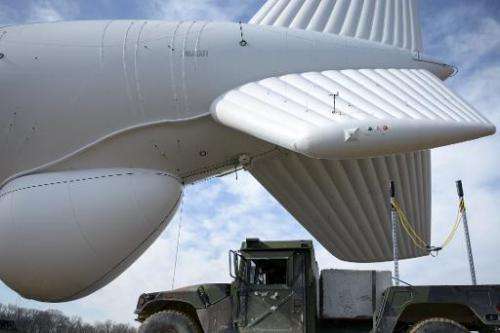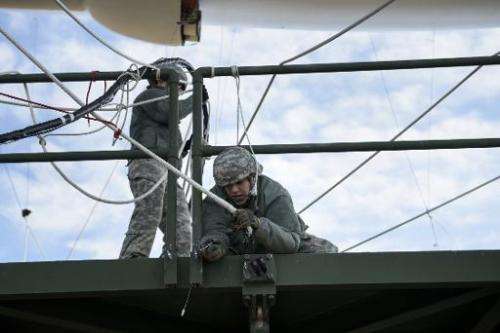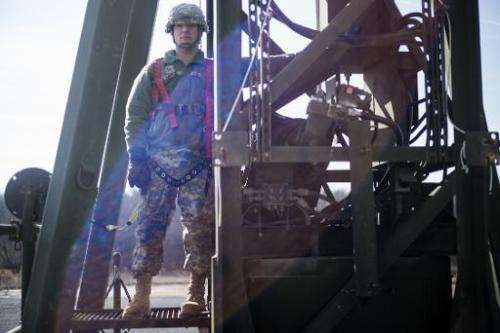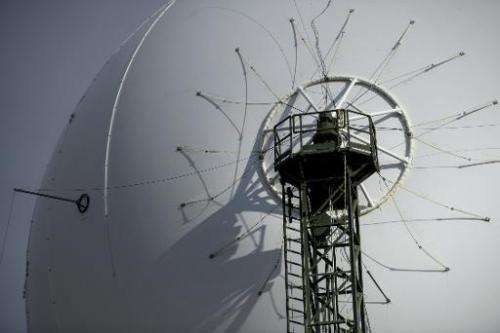A Humvee with a makeshift slingshot used to remove snow and ice from an aerostat is seen at the Aberdeen Proving Ground in Maryland
On a crisp winter's day, a tethered blimp almost as big as a football field slowly rises into the blue Maryland sky, casting its radar eye over greater Washington and well beyond.
The Joint Land Attack Cruise Missile Elevated Netted Sensor System, better known as JLENS, is intended to spot low-flying cruise missiles amid thousands of aircraft in this corner of the US east coast.
"This balloon is a radar that covers, oh, (a radius of) 300 miles (485 kilometers)—about the size of Texas —to allow us to see threats at a further distance out," said Colonel Frank Rice, commander of air defense operations for the US capital region.
"It provides a downward-looking view and integrates into a much larger air defense system," Rice told AFP as the blimp began to soar 10,000 feet (3,300 meters) above this military test site 50 miles (80 kilometers) northeast of Washington, where JLENS is undergoing a three-year trial.
Not everyone is happy with the bulbous unmarked white helium-filled blimp with a tumor-like radome on its belly, tied to Earth by a single Kevlar-like cable barely more than an inch (2.5 centimeters) thick.
On social media, local residents have wondered aloud if the aerostat—the correct name for a tethered airship —isn't Big Brother invading their privacy with its electronic 360-degree sweep.
"The JLENS military surveillance/defense blimp is floating just across the Susquehanna (river) from me," said freelance illustrator Bri Mercedes Weidner on Twitter. "Cool or creepy?"
Shared concerns
Civil liberties activists echo those concerns.
"There is a particular visceral reaction to looking up in the sky and seeing someone or something staring back at you," said Ginger McCall of the Electronic Privacy Information Center in Washington.
Combing through thousands of pages it obtained through the Freedom of Information Act, the non-profit group found no guarantee that JLENS won't be used for ground surveillance.
Instead, it came across contracts stating that "the technology was specifically designed to integrate very high definition video" to track and identify people and vehicles in a five-kilometer (three mile) radius," McCall told AFP.
Soldiers secure a line while mooring an aerostat to its mobile mooring station at the Aberdeen Proving Ground in Maryland
From the Aberdeen Proving Ground, a seaside patch of marsh and woodlands filled with white-tailed deer and unexploded World War II ordnance, such an area could include the busy Interstate 95 highway that links Washington with New York.
"It's important that we have ironclad checks and balances so that we can be assured that this powerful technology is not being used for domestic surveillance," lawyer Jay Stanley of the American Civil Liberties Union in Washington told AFP.
The Pentagon strongly denies that JLENS is equipped to look out for any non-flying targets, stating in an information document that the curvaceous blimps "cannot see people and do not have cameras on board."
"We don't even have a camera on top of it that would tell us if there was snow or ice up there," Rice told AFP over the roar of the big ventilation fans that cool the JLENS' electronic innards.
Not what it's for
Asked if JLENS could still, in theory, be fitted later on with high-def video gear, Rice acknowledged that "anything's possible—but that's not what we're using it for."
JLENS also faces a threat of its own—getting sustained funding from Congress, in competition with other high-price defense technology projects.
Last year, the Government Accountability Office estimated the cost of the JLENS program at $2.8 billion so far. Congress, meanwhile, nearly halved JLENS' $54 million budget for fiscal 2015.
Nearly a decade in development, only two JLENS blimps are operational—the one now flying, and another that is to go aloft nearby in a matter of months, but which is currently folded up in a shipping container "like a burrito," as one soldier put it.
A soldier stands at the base of a mooring tower waiting to deploy an aerostat, at the Aberdeen Proving Ground in Maryland
Together the pair make up an "orbit," with the ground crew of one aerostat assigned to 24/7 surveillance and the other tasked with directing air defense missiles to intercept a cruise missile in mid-flight.
Each blimp can stay aloft up to 30 days at a time, tethered to a dark green mobile mooring station, coming down to Earth only for maintenance—like a fresh shot of compressed helium—or extreme weather.
The main JLENS contractor is Raytheon, which ironically also makes the US military's sea-launched Tomahawk guided cruise missile.
On its website, it calls JLENS a relative bargain, at a time when President Barack Obama has asked Congress for $585 billion for defense in his 2016 budget.
Costs way more
A military aerostat is seen at its mobile mooring station, at the Aberdeen Proving Ground in Maryland
"A fixed-wing surveillance aircraft is 500-700 percent more expensive to operate than a JLENS during that same time period because of manpower, maintenance and fuel costs," the company says.
Some also question the need to guard against cruise missiles in a post-Cold War era when groups like al-Qaeda and Islamic State are perceived as greater security threats to the American homeland.
Rice contends, however, that one never knows what fresh new threat might be lurking over the horizon.
"Technology is growing by leaps and bound for everybody... We're just trying to stay ahead of our adversaries with this capability," he said.
© 2015 AFP






















